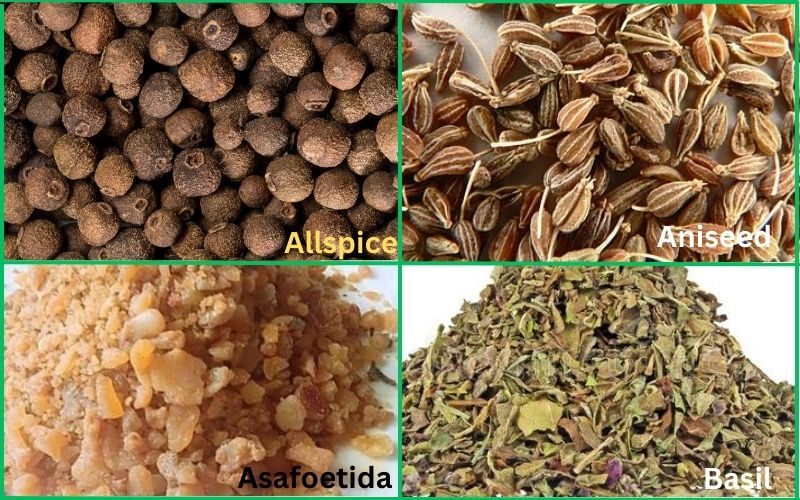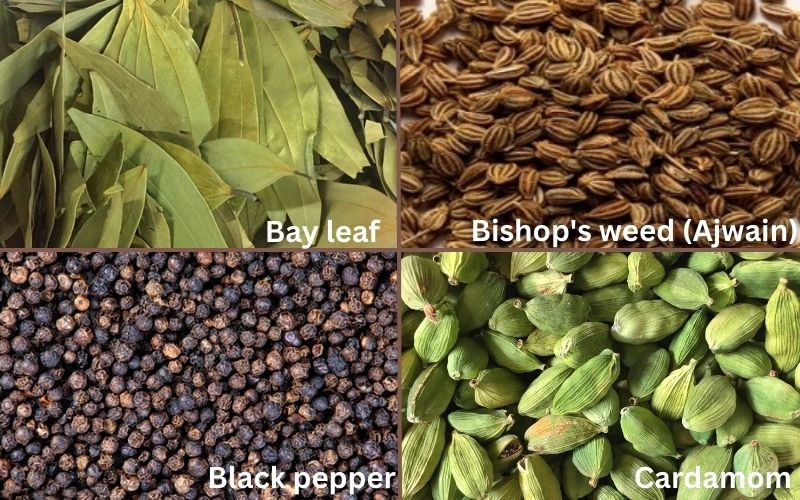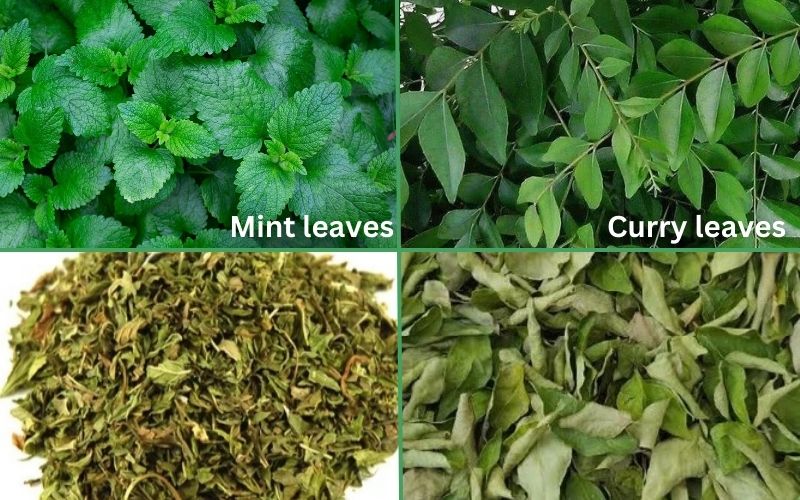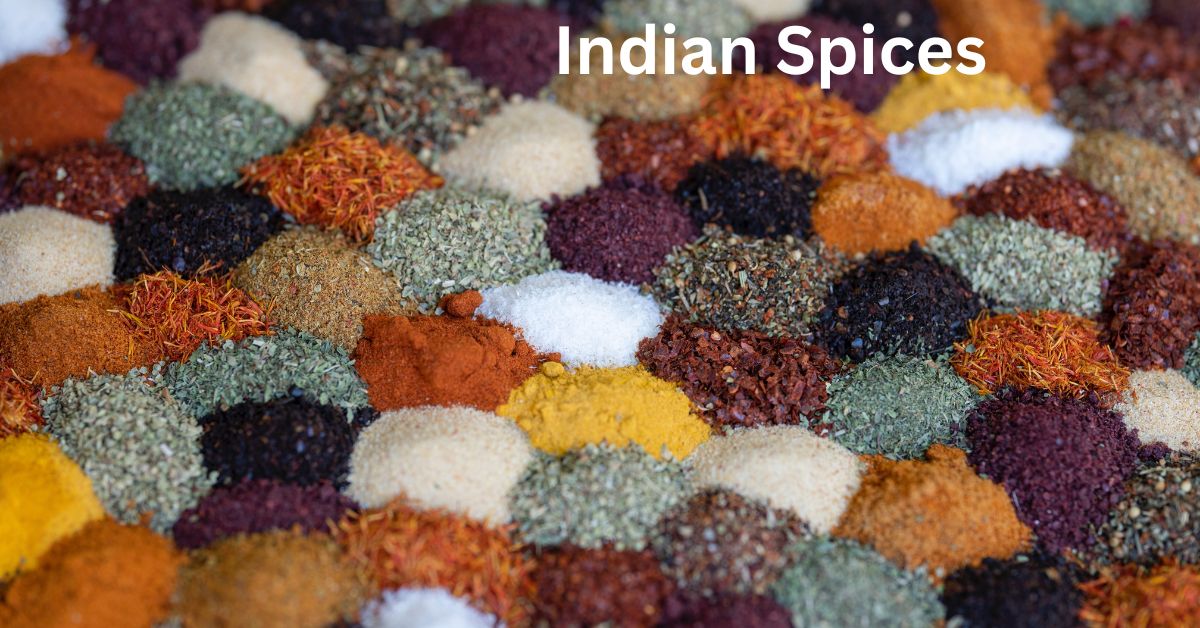Indian spices
Spices are defined as a seed, fruit, bark, root or other plant parts used to improve the taste and flavour of food.
Spices are also used for colouring and preserving a variety of foods. Spices are mostly used in dried form, i.e., whole-dried or in powdered form but they can also be used as fresh in preparing various food recipes.
Apart from culinary use, spices are also beneficial for human health in many ways. Many studies have proven the healing properties of different spices on human health.
Spices are considered antioxidants, anti-inflammatory and anti-bacterial agents that benefit the body in many ways. Common examples are ginger and turmeric which are used to treat various minor health problems.

India holds a prominent position in world spice production and produces a variety of spices due to the varying climate in many states of the country. Following are the major spices produced by India.
Indian spices
- Allspice
- Aniseed
- Asafoetida
- Basil
- Bay leaf
- Bishop’s weed
- Black Pepper
- Black Cardamom
- Cardamom (large)
- Cardamom (small)
- Cinnamon
- Chili
- Clove
- Coriander
- Cumin
- Ginger
- Mint
- Curry leaf
- Dill seed
- Fennel
- Fenugreek
- Garlic
- Ginger
- Marjoram
- Mustard
- Pepper
- Oregano
- Saffron
- Sage
- Turmeric
- Thyme

Indian spices
Brief information about some of the above spices is given below.
Allspice
Allspice trees grow up to a height of 8 to 10 meters. This tree is indigenous to West Indies (Jamaica), but few trees are found in Indian states like Maharashtra, Tamil Nadu, Kerala, etc. The tree produces small berries (7-9 mm diameter).
Use
Allspice is used in the food industry (more than 50%). Other uses are in the production of berry oil and oleoresin. Allspice is also used in the pharmaceutical and perfume industries.
Aniseed
Anise (also called aniseed) is an annual plant with an average height of 2-3 feet. Aniseed has a pleasant, aromatic taste. The flavour and aroma of seeds are similar to star anise and fennel.
It is widely cultivated in Bulgaria, Cyprus, France, Germany, Italy, Mexico, South America, Spain, etc. In India, anise is grown as a culinary herb or as a garden plant. Hindi name: Vilayati saunf
Use
The useful part is seed (fruit) and oil. Less frequently, leaves are used. Aniseed is used for flavouring food, candy, alcoholic drinks for both culinary and medicinal purposes.
The fruits of anis (called aniseed) are widely used for flavouring curries, soups, baked products, deserts, pickles, etc. Its essential oil is valuable in perfumery.

Indian spices
Asafoetida
Asafoetida (Hindi name: Hing) is the dried latex exuded from the living underground rhizome of several species of Ferula (a perennial herb of 3 to 5 feet height).
These species are native to the deserts of Iran and mountains of Afghanistan. In India, it is grown in Kashmir and in some parts of Punjab.
There are two main varieties of asafoetida, i.e., Hing Kabuli Safaid (milky white asafoetida) and Hing Lal (Red asafoetida). The white or pale variety of asafoetida is water-soluble, whereas the dark or black variety is oil-soluble. Asafoetida has a pungent smell, but the odor dissipates upon cooking.
Use
Asafoetida is extensively used for flavouring curries, sauces, and pickles.
It is also used as a medicine in Indian systems of medicine like Ayurveda.
Basil
Though there are many varieties of basil, sweet basil is one of the most popular and widely used varieties to grow. Sweet basil is used in cooking for its aroma.
Basil is one of the most widely used herbs in the world, and it adds a sweet flavour and warm aroma to food when used with other spices.
Use
The dried leaves of basil are used as spices for flavouring. The sweet basil oil is obtained by steam distillation of basil leaves and stems and is widely used in perfumery.
Bay leaf
Bay leaf (Hindi name: Tezpatta) is the dried leaf of an evergreen tree attaining a height of 15 to 20 metres.
Bay leaves come from several plants, such as Bay laurel (Laurus nobilis), California bay leaf, Indian bay leaf or malabathrum (Indian bay leaf differs from bay laurel leaves, which are shorter and light- to medium-green in colour), Indonesian bay leaf, West Indian bay leaf, and Mexican bay leaf.
Indian bay leaves are about two times longer and wider than bay laurel, and they have a fragrance and taste similar to cinnamon.
Use
In Indian cuisine, bay leaves are used in rice dishes like Biryani and as an ingredient in Garam masala.
The essential oil obtained from the leaves is also used as spice and food flavouring agent.
Indian spices
Bishop’s weed (Ajwain)
Though Bishop’s weed is a common name for some other plants, in the context of spices, it is known as ajowan caraway or carom. The Hindi name of Bishop’s weed is Ajwain.
It is an annual herb of approximately 90 cm height in the family Apiaceae, bearing greyish-brown seedlike fruits.
Ajwain is cultivated in many states of India; however, the major Ajwain-producing states are Rajasthan, Gujarat, Andhra Pradesh, Telangana, Madhya Pradesh, etc.
Depending on variety and season, the crop matures in 130–180 days. Harvesting time for this crop is usually from February to April.
After harvesting, the crop is stacked for drying. Properly cleaned and graded seeds are stored with an initial moisture content of 7-8%.
Processing
Dried seeds are introduced for distillation to obtain the essential oil. Hydro- or steam distillation method
is generally used for the extraction of essential oil from Ajwain seeds.
According to some past research, the Ajwain crop shows considerable variation in different states, and the seeds yield essential oils up to 3.9% in the plains and up to 4.9 % in cold areas.
The essential oil is dominated by thymol. Besides this, a-pinene, p-cymene, limonene, and d-terpinene have been found.
Use
Ajwain is a common ingredient in every Indian kitchen. It is used for making curry, parathas (flaky flatbreads), samosas, and rotis.
Besides this, ajwain is widely used in the Ayurvedic system of medicine to treat various health problems, such as asthma and indigestion.
The food processing industry also uses the ajwain to make a variety of processed foods, such as a variety of snack products, breads, biscuits, pastries, etc.

Black Pepper
Black pepper (Hindi name: Kali mirch), which is also known as the King of Spices, is one of the most important spices in the world and India.
It is the dried, mature, but unripe berries of Piper nigrum. P. nigrum is a perennial shrub grown in hot and moist parts of southern India.
In India, black pepper-producing states are Kerala, Tamil Nadu, Pondicherry, Karnataka, etc. Black pepper-producing countries are Vietnam, Indonesia, Brazil, Sri Lanka, China, Malaysia, etc.
Chemical constituents
Peperine
Processing of black pepper
Pepper vines start yielding usually from the 3rd or 4th year. Harvesting of black pepper is done from November to February in the plains and from January to March in the hills.
After the berries are separated from the spikes, they are sun dried for about 7 to 10 days until the outer skin becomes black. In cases of unfavourable weather, mechanical drying may be followed.
Cleaning and grading are important unit operations before packaging and storage. For this, sieves and separators are used for quick separation of dust, stalks, good berries, immature, small berries, etc.
Pepper is graded according to size and density.
Destoners, air classifiers, gravity separators, and colour sorters of proper capacity may be used in the processing of peppers.
Indian spices
Cardamom
Cardamom is the dried fruit of a plant belonging to the Zingiberaceae family.
Cardamom is recognised by its small, black seeds, which have a pleasant aroma.
Cardamom is broadly grouped into 2 categories.
- Small Cardamom (Chhoti Elaichi)
- Large Cardamom (Badi Elaichi)
Small cardamom is commercially important than large cardamom. It is one of the most valued spice of the world and so called as ‘Queen of spices’.
Small cardamom is also called as green cardamom and true cardamom.
Apart from India, small cardamom is also produced in countries like Guatemala, Indonesia, Nepal, Laos etc.
Small cardamom is more commercially important than large cardamom. It is one of the most valuable spices in the world and is called the ‘Queen of Spices.”
Small cardamom is also called green cardamom and true cardamom. Apart from India, small cardamom is also produced in countries like Guatemala, Indonesia, Nepal, Laos, etc.
Use
Cardamom is one of the common ingredients in Indian cooking. Both forms of cardamom are used for flavouring food and drink.
Cardamom powder is used as a spice for making sweet dishes and flavouring, as well as a traditional flavouring in coffee and tea.
Cinnamon
Cinnamon is obtained from the inner bark of tree species in the genus Cinnamomum. Cinnamon is one of the most important spices.
Cinnamon is an aromatic spice that is used as a flavouring additive in many dishes, including breakfast, tea, and traditional foods.
Cinnamon primarily contains vital oils and other derivatives, such as cinnamaldehyde, cinnamic acid, and cinnamate.
Use
Cinnamon is used in the aroma and essence industries due to its fragrance.

Indian spices
Chili
Chili is the dried ripe fruit of the genus Capsicum (Family: Solanaceae), cultivated for its pungency.
Chilies are widely used in many food dishes as a spice.
Use
Chilies are used widely due to their pungency in Indian cuisine. A variety of dishes can be made with green chilies, red chilies, and their paste or powder.
To make chili powder, whole pods are dried and then crushed into powder.
Clove
Clove (Syzygium aromaticum) is a valuable spice that has been used for centuries as a food preservative and in various ways due to its many medicinal properties.
Clove is dried unopened flower bud of evergreen tree of about 10-12 meters. Clove trees start flowering after approximately 7 years.
The plant is indigenous to Indonesia but now is cultivated in many other countries, including India.
Use
Clove is used mainly for flavouring food. Clove flavour blends well with both sweet and savoury dishes.
The clove oils are used in dentistry and oral treatments. It is also used in preparations for toothpaste and mouthwashes.
Coriander
Coriander (Coriandrum sativum) is also known as Dhania in the Hindi language. It is an annual herb in the family Apiaceae.
Fresh leaves, as such or in ground form, are used while making salads, soups, curries, etc. The seeds of the plant are also used whole or in powdered form while making curries.
Coriander seeds are also used in India’s traditional health care for various health problems.

Cumin
Cumin (Cuminum cyminum) (Hindi name: Jeera) is a flowering plant grown for its seed in the family Apiaceae. Cumin is one of the most popular spices in India and the world.
Cumin is widely used in various food dishes such as the yoghurt dish raita, curries like Aalu jira (potatoes with cumin), Jira rice (rice cooked with cumin), masala dosa, and in making the popular spice blend garam masala. The seeds are also used in traditional medicine.
Cumin’s flavour and warm aroma are due to its essential oil. Cumin contains approximately 2.5–4% essential oils, of which several compounds (the primary aroma compound is cuminaldehyde) contribute to its complex flavour.
Ginger
Ginger (Zingiber officinale) is a plant whose rhizomes are used widely as a spice. Ginger is also used widely in Ayurveda for treating various health problems.
India is the largest producer of ginger in the world. Ginger is used in a variety of food items, such as while making curry, pickles, candy, soda, tea, and alcoholic beverages.

Mint
Mint (also known as Mentha) is an aromatic herb and a genus of plants in the family Lamiaceae. The fresh or dried leaves of mint are widely used for flavouring food and beverages.
Mint essential oil has also been used in flavouring food. Mint essential oil is also used in the pharmaceutical and perfumery sectors.
Mint covers peppermint, spearmint, Japanese peppermint, and many other similar plants.
Curry leaves
The leaves of the curry tree are used as spices. The curry tree (Murraya koenigii) in the family Rutaceae grows (to a height of 4-6 metres) in tropical and subtropical regions.
It is also known as meetha neem in Hindi. In Indian cooking, the use of curry leaves is common.
Fresh leaves are usually fried in vegetable oil with mustard seeds, chopped onions, and other spices to make delicious vegetable curry.
Fresh or dried curry leaves are also used while making Kadhi, Dosa, Rasam, and many other Indian traditional recipes.

Dill Seed
Plant Height: 2 to 2.5 feet
Plant parts used: Seed and leaves. Commonly used in soups, sausage, pickles.
Dill seed is a popular herb of apiaceae family which is widely used as spice. It also yields essential oil. Leaves of Dill crop has pleasant smell. The Indian dill plant looks like fennel plant. Dill seeds (Anethum graveolens L.) are used whole or ground in soups, salads, sausage and pickling. The major states of India producing Dill seeds are Gujarat, Uttar Pradesh, Punjab, West Bengal etc.




